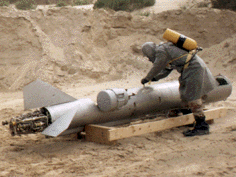
The Mikoyan-Gurevich MiG-19 is a Soviet second generation, single-seat, twinjet fighter aircraft, the world's first mass-produced supersonic aircraft. It was the first Soviet production aircraft capable of supersonic speeds in level flight. A comparable U.S. "Century Series" fighter was the North American F-100 Super Sabre, although the MiG-19 primarily fought against the more modern McDonnell Douglas F-4 Phantom II and Republic F-105 Thunderchief over North Vietnam. This aircraft was originally used by the Soviet Union but it was later used by the People's Liberation Army Air Force.

The Tupolev Tu-16 is a twin-engined jet strategic heavy bomber used by the Soviet Union. It has been flown for almost 70 years, and the Chinese license-built Xian H-6 remains in service with the People's Liberation Army Air Force.

The Raduga Kh-15 or RKV-15 is a Russian hypersonic aero-ballistic air-to-ground missile carried by the Tupolev Tu-22M and other bombers. Originally developed as a standoff nuclear air-to-ground missile similar to the U.S. Air Force's AGM-69 SRAM, versions with conventional warheads have been developed.

The Kh-55 is a Soviet/Russian subsonic air-launched cruise missile, designed by MKB Raduga in the 1970s. It has a range of up to 2,500 km (1,350 nmi) and can carry nuclear warheads. Kh-55 is launched exclusively from bomber aircraft and has spawned a number of conventionally armed variants mainly for tactical use, such as the Kh-65SE and Kh-SD, but only the Kh-101 and Kh-555 appear to have been put into service. Contrary to popular belief, the Kh-55 was not the basis of the submarine and ground-launched S-10 Granat or RK-55 Relief designed by NPO Novator. The RK-55 is very similar to the air-launched Kh-55 but the Kh-55 has a drop-down turbofan engine and was designed by MKB Raduga.

The Novator KS-172 was a Russian air-to-air missile project designed as an "AWACS killer" at ranges up to 400 km. The missile had various names during its history, including K-100, Izdeliye 172, AAM-L (RVV-L), KS–172, KS-1, 172S-1 and R-172. The airframe appears to have been derived from the 9K37 Buk surface-to-air missile (SAM) but development stalled in the mid-1990s for lack of funds. It appears to have restarted in 2004 after a deal with India, who wants to produce the missile in India for their Su-30MKI fighters. Nowadays the development is stopped and the project is closed.

The R-73 is a short-range air-to-air missile developed by Vympel NPO that entered service in 1984.

An air-to-surface missile (ASM) or air-to-ground missile (AGM) is a missile designed to be launched from military aircraft at targets on land or sea. There are also unpowered guided glide bombs not considered missiles. The two most common propulsion systems for air-to-surface missiles are rocket motors, usually with shorter range, and slower, longer-range jet engines. Some Soviet-designed air-to-surface missiles are powered by ramjets, giving them both long range and high speed.

MKB Raduga is a Russian aerospace company, concerned with the production of various missile-systems and related technologies. It is headquartered in Dubna, Moscow Oblast. Formerly a division of the Mikoyan-Gurevich design bureau, it was spun off as a separate OKB in March 1957.
The Raduga Kh-20 was an air launched cruise missile armed with a thermonuclear warhead which was developed by the Soviet Union during the Cold War. The Kh-20 was designed to be air-launched.
The Kh-29 is a Soviet air-to-surface missile with a range of 10–30 km. It has a large warhead of 320 kg, has a choice of laser, infrared, active radar or TV guidance, and is typically carried by tactical aircraft such as the Su-24, Su-30, MiG-29K as well as the Su-25, giving these aircraft an expanded standoff capability.

The Kh-25/Kh-25M is a family of Soviet lightweight air-to-ground missiles with a modular range of guidance systems and a range of 10 km. The anti-radar variant (Kh-25MP) is known to NATO as the AS-12 'Kegler' and has a range up to 40 km. Designed by Zvezda-Strela, the Kh-25 is derived from the laser-guided version of the Kh-23 Grom. The Kh-25 remains in widespread use despite the apparent development of a successor, the Kh-38.

The Kh-59 Ovod is a Russian TV-guided cruise missile with a two-stage solid-fuel propulsion system and 200 km range. The Kh-59M Ovod-M is a variant with a bigger warhead and turbojet engine. It is primarily a land-attack missile but the Kh-59MK variant targets ships.

The Main Missile and Artillery Directorate of the Ministry of Defense of the Russian Federation, commonly referred to by its transliterated Russian acronym GRAU (ГРАУ), is a department of the Russian Ministry of Defense. It is subordinate to the Chief of Armament and Munition of the Russian Armed Forces, a vice-minister of defense.

The Kh-58 is a Soviet anti-radiation missile with a range of 120 km. As of 2004 the Kh-58U variant was still the primary anti-radiation missile of Russia and its allies. It is being superseded by the Kh-31. The NATO reporting name is "Kilter".

The Raduga KSR-5 was a long-range, air-launched cruise missile and anti ship missile developed by the Soviet Union. It was essentially a scaled down version of the Kh-22 'Kitchen', built to be carried by the less capable Tu-16.

The Kh-28 was the first Soviet anti-radiation missile for tactical aircraft. It entered production in 1973 and is still carried on some Sukhoi Su-22s in developing countries but is no longer in Russian service. Use of the Kh-28 was restricted by its weight, limited seeker head, bulk and fuelling requirements, and it was superseded by the smaller, solid-fuel Kh-58 in the early 1980s.
10Kh was the designation for the initial series of Soviet Union pulse jet engine powered air-launched cruise missiles, reverse engineered from the Fieseler Fi 103 (V-1) flying bomb, developed in the 1950s by OKB-52 under the leadership of Vladimir Nikolaevič Čelomej (Chelomey) and cancelled in the same decade.













